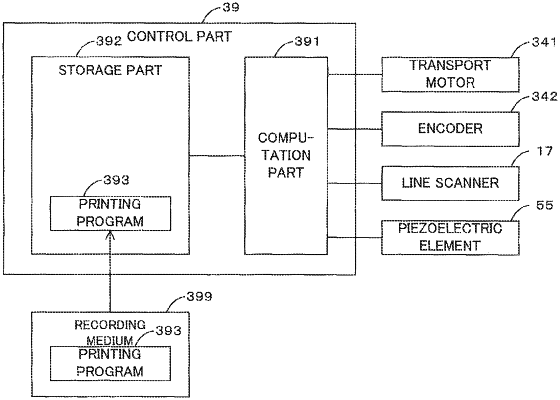| CPC B41J 2/04573 (2013.01) [B41J 2/04541 (2013.01); B41J 2/04581 (2013.01); B41J 2/04588 (2013.01)] | 5 Claims |

|
1. A printer, comprising:
an ejection head having a pressure chamber storing ink therein, a nozzle communicating with the pressure chamber, and a driving element giving pressure variation to the ink inside the pressure chamber;
a driving part configured to move a printing medium facing the nozzle relatively to the ejection head; and
a control part configured to determine N output timings from a first output timing to an N-th output timing which are arranged in chronological order and outputs an ejection signal to the driving element at each of the N output timings, N being an integer not smaller than 2,
wherein the driving element gives the pressure variation to the ink inside the pressure chamber in response to the ejection signal received from the control part, to thereby eject the ink from the nozzle,
the control part performs a timing determination operation in which N candidate timings from a first candidate timing to an N-th candidate timing which are arranged in chronological order at a time interval in accordance with a relative speed of the printing medium to the ejection head are set and the N output timings are determined on the basis of a prohibition interval provided to a predetermined range at which a predetermined time elapsed from a starting point timing and the N candidate timings,
the first candidate timing among the N candidate timings is set as the first output timing among the N output timings, and
in the timing determination operation, when the I-th candidate timing is set outside the prohibition interval whose starting point timing is the (I−1)-th output timing, the I-th candidate timing is determined as the I-th output timing, and on the other hand, when the I-th candidate timing is set inside the prohibition interval whose starting point timing is the (I−1)-th output timing, a computation to determine that a timing after the prohibition interval is the I-th output timing is performed for the second and later candidate timings in chronological order, I being an integer not smaller than 2 and not larger than N.
|